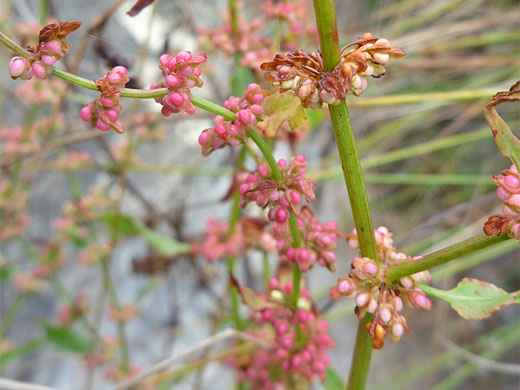
Elongated, whorled inflorescence of rumex conglomeratus, Ossagon Trail, Prairie Creek Redwoods National Park, California
Common names:
Sharp dock, clustered dock
Family:
Scientific name:
Rumex conglomeratus
Main flower color:
Range:
South Arizona, the Pacific states and small parts of Texas and Oklahoma (non native)
Height:
Up to 45 inches
Habitat:
Lakeshores, marshes, wet meadows, from sea level to 3,500 feet
Leaves:
Lanceolate, oblong or obovate, up to 12 inches long and 6 inches wide
Season:
May to August
Rumex conglomeratus originates in Europe and Asia and has been introduced to several states in the US; it is most widespread in coastal regions of California. All plant parts are usually hairless. Stems grow vertically upwards, and may branch a few times above the middle. Large leaves grow at regular intervals along the stems; they have a prominent midvein and somewhat irregular margins. Leaf bases may be tapering or slightly lobed (cordate).
The inflorescence occupies the upper half of the stem; a series of compact, whorled clusters of small, pink or reddish flowers (numbering between 10 and 20), one inch or more apart; all but the uppermost few are subtended by leaves. Flowers are formed of six tepals, the inner three larger than the outer, between which are three egg-shaped tubercles. The fruits (achenes) are initially pinkish, ageing to brown.
The inflorescence occupies the upper half of the stem; a series of compact, whorled clusters of small, pink or reddish flowers (numbering between 10 and 20), one inch or more apart; all but the uppermost few are subtended by leaves. Flowers are formed of six tepals, the inner three larger than the outer, between which are three egg-shaped tubercles. The fruits (achenes) are initially pinkish, ageing to brown.
All Contents © Copyright The American Southwest | Comments and Questions | Contribute | Site Map


